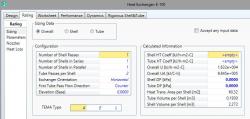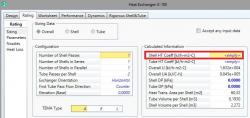Dear all,
I have a problem in rating and simulation of a heat exchanger. I have used both software Aspen HYSYS and Aspen EDR.
The exchanger surface area is 260 m2, containing 961 tubes. I want to check if this exchanger can be used for a specific heat exchange task.
A 220 tone/h propane stream at bubble point, 17 bar and 48 C enters the shell side. Also, a stream of 975 ton/h n-C11 (normal undecane) at 10 bar and 99 C enters the tubes. So, propane should begin boiling in shell side and exit the exchanger in two phase condition. Also, n-C11 should exit exchanger at 83 C.
My main problem is that Aspen HYSYS and Aspen EDR predict different heat transfer coefficients for the shell side (boiling propane). Aspen HYSYS predicts a heat trasnsfer coeffiient of 8430 Kj/hr.m2.C while EDR predicts 30650 Kj/hr.n2.C. Therefore, I can not determine whether the heat transfer area of 260 m2 is enough for this separation or not.
I do not know which value of heat transfer coefficient I should use and I would appreciate your helps.

 FB
FB















